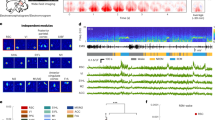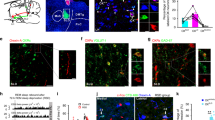Abstract
Rapid eye movement (REM) sleep consists of a dreaming state in which there is activation of the cortical and hippocampal electroencephalogram (EEG), rapid eye movements, and loss of muscle tone. Although REM sleep was discovered more than 50 years ago, the neuronal circuits responsible for switching between REM and non-REM (NREM) sleep remain poorly understood. Here we propose a brainstem flip–flop switch, consisting of mutually inhibitory REM-off and REM-on areas in the mesopontine tegmentum. Each side contains GABA (γ-aminobutyric acid)-ergic neurons that heavily innervate the other. The REM-on area also contains two populations of glutamatergic neurons. One set projects to the basal forebrain and regulates EEG components of REM sleep, whereas the other projects to the medulla and spinal cord and regulates atonia during REM sleep. The mutually inhibitory interactions of the REM-on and REM-off areas may form a flip–flop switch that sharpens state transitions and makes them vulnerable to sudden, unwanted transitions—for example, in narcolepsy.
This is a preview of subscription content, access via your institution
Access options
Subscribe to this journal
Receive 51 print issues and online access
$199.00 per year
only $3.90 per issue
Buy this article
- Purchase on Springer Link
- Instant access to full article PDF
Prices may be subject to local taxes which are calculated during checkout





Similar content being viewed by others
References
McCarley, R. W. Mechanisms and models of REM sleep control. Arch. Ital. Biol. 142, 429–467 (2004)
Kayama, Y., Ohta, M. & Jodo, E. Firing of ‘possibly’ cholinergic neurons in the rat laterodorsal tegmental nucleus during sleep and wakefulness. Brain Res. 569, 210–220 (1992)
Steriade, M., Pare, D., Datta, S., Oakson, G. & Curro Dossi, R. Different cellular types in mesopontine cholinergic nuclei related to ponto-geniculo-occipital waves. J. Neurosci. 10, 2560–2579 (1990)
Wu, M. F. et al. Activity of dorsal raphe cells across the wake–sleep cycle and during cataplexy in narcoleptic dogs. J. Physiol. (Lond.) 554, 202–215 (2004)
Hobson, J. A., McCarley, R. W. & Nelson, J. P. Location and spike-train characteristics of cells in anterodorsal pons having selective decreases in firing rate during desynchronized sleep. J. Neurophysiol. 50, 770–783 (1983)
Aston-Jones, G. & Bloom, F. E. Activity of norepinephrine-containing locus coeruleus neurons in behaving rats anticipates fluctuations in the sleep–waking cycle. J. Neurosci. 1, 876–886 (1981)
Kubin, L. Carbachol models of REM sleep: recent developments and new directions. Arch. Ital. Biol. 139, 147–168 (2001)
Coleman, C. G., Lydic, R. & Baghdoyan, H. A. M2 muscarinic receptors in pontine reticular formation of C57BL/6J mouse contribute to rapid eye movement sleep generation. Neuroscience 126, 821–830 (2004)
Wilson, S. & Argyropoulos, S. Antidepressants and sleep: a qualitative review of the literature. Drugs 65, 927–947 (2005)
Jones, B. E., Harper, S. T. & Halaris, A. E. Effects of locus coeruleus lesions upon cerebral monoamine content, sleep–wakefulness states and the response to amphetamine in the cat. Brain Res. 124, 473–496 (1977)
Mouret, J. & Coindet, J. Polygraphic evidence against a critical role of the raphe nuclei in sleep in the rat. Brain Res. 186, 273–287 (1980)
Shouse, M. N. & Siegel, J. M. Pontine regulation of REM sleep components in cats: integrity of the pedunculopontine tegmentum (PPT) is important for phasic events but unnecessary for atonia during REM sleep. Brain Res. 571, 50–63 (1992)
Chemelli, R. M. et al. Narcolepsy in orexin knockout mice: molecular genetics of sleep regulation. Cell 98, 437–451 (1999)
Lee, M. G., Hassani, O. K. & Jones, B. E. Discharge of identified orexin/hypocretin neurons across the wake–sleep cycle. J. Neurosci. 25, 6716–6720 (2005)
Mileykovskiy, B. Y., Kiyashchenko, L. I. & Siegel, J. M. Behavioral correlates of activity in identified hypocretin/orexin neurons. Neuron 46, 787–798 (2005)
Thannickal, T. C. et al. Reduced number of hypocretin neurons in human narcolepsy. Neuron 27, 469–474 (2000)
Lu, J. et al. Selective activation of the extended ventrolateral preoptic nucleus during rapid eye movement sleep. J. Neurosci. 22, 4568–4576 (2002)
Marcus, J. N. et al. Differential expression of orexin receptors 1 and 2 in the rat brain. J. Comp. Neurol. 435, 6–25 (2001)
Sastre, J. P., Buda, C., Kitahama, K. & Jouvet, M. Importance of the ventrolateral region of the periaqueductal gray and adjacent tegmentum in the control of paradoxical sleep as studied by muscimol microinjections in the cat. Neuroscience 74, 415–426 (1996)
Boissard, R. et al. The rat ponto-medullary network responsible for paradoxical sleep onset and maintenance: a combined microinjection and functional neuroanatomical study. Eur. J. Neurosci. 16, 1959–1973 (2002)
Sakai, K., Crochet, S. & Onoe, H. Pontine structures and mechanisms involved in the generation of paradoxical (REM) sleep. Arch. Ital. Biol. 139, 93–107 (2001)
Onoe, H. & Sakai, K. Kainate receptors: a novel mechanism in paradoxical (REM) sleep generation. Neuroreport 6, 353–356 (1995)
Boissard, R. et al. Localization of the GABAergic and non-GABAergic neurons projecting to the sublaterodorsal nucleus and potentially gating paradoxical sleep onset. Eur. J. Neurosci. 18, 1627–1639 (2003)
Saper, C. B., Chou, T. C. & Scammell, T. E. The sleep switch: hypothalamic control of sleep and wakefulness. Trends Neurosci. 24, 726–731 (2001)
Saper, C. B., Scammell, T. E. & Lu, J. Hypothalamic regulation of sleep and circadian rhythms. Nature 437, 1257–1263 (2005)
Sastre, J. P. & Jouvet, M. Oneiric behavior in cats. Physiol. Behav. 22, 979–989 (1979)
Sanford, L. D. et al. Sleep patterning and behaviour in cats with pontine lesions creating REM without atonia. J. Sleep Res. 3, 233–240 (1994)
Plazzi, G. et al. Pontine lesions in idiopathic narcolepsy. Neurology 46, 1250–1254 (1996)
Rye, D. B. et al. Medullary and spinal efferents of the pedunculopontine tegmental nucleus and adjacent mesopontine tegmentum in the rat. J. Comp. Neurol. 269, 315–341 (1988)
Sastre, J. P., Sakai, K. & Jouvet, M. Are the gigantocellular tegmental field neurons responsible for paradoxical sleep? Brain Res. 229, 147–161 (1981)
Alvarez, F. J. et al. Postnatal phenotype and localization of spinal cord V1 derived interneurons. J. Comp. Neurol. 493, 177–192 (2005)
Taal, W. & Holstege, J. C. GABA and glycine frequently colocalize in terminals on cat spinal motoneurons. Neuroreport 5, 2225–2228 (1994)
Chase, M. H., Soja, P. J. & Morales, F. R. Evidence that glycine mediates the postsynaptic potentials that inhibit lumbar motoneurons during the atonia of active sleep. J. Neurosci. 9, 743–751 (1989)
Kapas, L. et al. The effects of immunolesions of nerve growth factor-receptive neurons by 192 IgG–saporin on sleep. Brain Res. 712, 53–59 (1996)
Gerashchenko, D., Salin-Pascual, R. & Shiromani, P. J. Effects of hypocretin–saporin injections into the medial septum on sleep and hippocampal theta. Brain Res. 913, 106–115 (2001)
Manford, M. & Andermann, F. Complex visual hallucinations. Clinical and neurobiological insights. Brain 21, 1819–1840 (1998)
Kimura, K. et al. A discrete pontine ischemic lesion could cause REM sleep behavior disorder. Neurology 55, 894–895 (2000)
Braak, H. et al. Parkinson's disease: affection of brain stem nuclei controlling premotor and motor neurons of the somatomotor system. Acta Neuropathol. (Berl.) 99, 489–495 (2000)
Chou, T. C. et al. Critical role of dorsomedial hypothalamic nucleus in a wide range of behavioral circadian rhythms. J. Neurosci. 23, 10691–10702 (2003)
Acknowledgements
We thank Q. H. Ha and M. Ha for technical expertise. This work was supported by United States Public Health Service grants.
Author information
Authors and Affiliations
Corresponding authors
Ethics declarations
Competing interests
Reprints and permissions information is available at npg.nature.com/reprintsandpermissions. The authors declare no competing financial interests.
Supplementary information
Supplementary Figure 1
The REM flip-flop switch is part of a cascading pair of switches that generate forebrain vs. brainstem-spinal manifestations of REM sleep. (JPG 71 kb)
Supplementary Notes
This file contains text to accompany the above Supplementary Figure and Supplementary Methods. (DOC 45 kb)
Rights and permissions
About this article
Cite this article
Lu, J., Sherman, D., Devor, M. et al. A putative flip–flop switch for control of REM sleep. Nature 441, 589–594 (2006). https://doi.org/10.1038/nature04767
Received:
Accepted:
Published:
Issue Date:
DOI: https://doi.org/10.1038/nature04767
This article is cited by
-
Adenosine-independent regulation of the sleep–wake cycle by astrocyte activity
Cell Discovery (2023)
-
Neuro-orchestration of sleep and wakefulness
Nature Neuroscience (2023)
-
Study on reverse transsynaptic virus tracing targeting Shenmen (HT7) and heart in mice
Journal of Acupuncture and Tuina Science (2023)
-
Neural Control of REM Sleep and Motor Atonia: Current Perspectives
Current Neurology and Neuroscience Reports (2023)
-
Clonazepam for the management of sleep disorders
Neurological Sciences (2023)
Comments
By submitting a comment you agree to abide by our Terms and Community Guidelines. If you find something abusive or that does not comply with our terms or guidelines please flag it as inappropriate.



